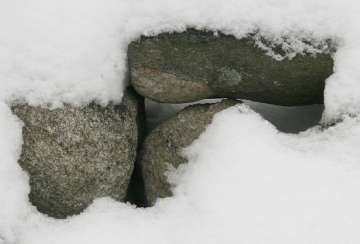

PHOTO COURTESY OF GARRY KESSLER
Snow on stones in a stone wall makes a portrait of January in Westborough. One sign of life is the small round patch of lichen growing on the top stone. When spring comes, the stone wall will be habitat and hiding place for wildlife such as chipmunks, mice, and snakes.
January 14, 2011, Page 4-5
NATURE NOTES
By Annie Reid
Westborough Community Land Trust
Take the annual nature quiz
Here we are in January again – a time when most of us turn into couch potatoes (when we’re not out shoveling snow). But think of nature and the delights it offers us throughout the year! To give your memory a little jog, take our annual Nature Notes quiz.
Below you'll find short descriptions of plants, animals, or other natural things featured in Nature Notes in 2010. Match these descriptions with names in the list of possible answers that follows.
Choose your answers from the drop down lists. Check your answers by clicking the "Show Answers" button. The answer page will contain links to the 2010 columns about the plants and animals so you can read them again if you wish.
If all – or almost all – of your answers are correct, email your name or your group’s name to us at NatureNotes@westboroughlandtrust.org. We'll congratulate the top scorers in a future issue of the Westborough News – the more top scorers, the better.